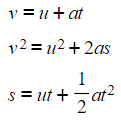Class 10 Exam > Class 10 Notes > Mathematics for GCSE/IGCSE > Algebra Basics
Algebra Basics | Mathematics for GCSE/IGCSE - Class 10 PDF Download
Substitution
What is substitution?
- Substitution involves replacing letters in a formula with their respective values to find another value within the formula.
How to substitute numbers into a formula?
- Write down the formula if not clearly stated in the question.
- Substitute the given numbers, using brackets for negative numbers like (-3), (-5), etc.
- Simplify any calculations whenever possible.
- Rearrange the formula if necessary (substituting first is usually easier).
- Work out the calculation (use a calculator if permitted).
Are there any common formulae to be aware of?
- The formula for the equation of a straight line is frequently utilized.

- Formulae related to accelerating objects are commonly applied.

Key Definitions and Meanings
- t: Represents the time an object accelerates for (in seconds).
- u: Denotes the initial speed of the object (in m/s) - the speed at the beginning.
- v: Indicates the final speed of the object (in m/s) - the speed after t seconds.
- a: Stands for the acceleration (in m/s^2) experienced during that time.
- s: Represents the distance covered by the object in t seconds.
- You do not necessarily need to memorize these formulae, but it is essential to understand how to substitute numerical values into them for practical applications.
Collecting Like Terms
How do we collect like terms?
- Terms in algebraic expressions are separated by plus (+) or minus (-) signs.
- The sign in front of a term belongs to the coefficient of the term that follows the symbol.
- If there is no symbol in front of the first term, it is considered a positive term.
- For instance, in the expression 2x - 3y, we have 2x and -3y.
- Like terms must possess identical letters and powers, although their coefficients can vary.
- Examples of like terms include: 2x and 3x, 2x2 and 3x2, 2xy and 3xy, 4(x + y) and 5(x + y).
- Examples of non-like terms are: 2x and 3y (different letters), 2x2 and 3x4 (different powers), 2xy and 3xyz (different letters), 4(x + y) and 5(x + y2).
- Remember that multiplication can be done in any order (xy and yx are like terms).
- Add the COEFFICIENTS of like terms
- If the answer is a positive answer then put "+" in front if there are other terms before it
- x - 2y + 5y = x + 3y
- If the answer is a negative number then put "-" in front
- x - 5y + 2y = x - 3y
- If the answer is a positive answer then put "+" in front if there are other terms before it
The document Algebra Basics | Mathematics for GCSE/IGCSE - Class 10 is a part of the Class 10 Course Mathematics for GCSE/IGCSE.
All you need of Class 10 at this link: Class 10
|
38 videos|413 docs|19 tests
|
FAQs on Algebra Basics - Mathematics for GCSE/IGCSE - Class 10
| 1. How do you use substitution in algebra? |  |
Ans. Substitution in algebra involves replacing variables with known values in an equation to simplify and solve it. Simply substitute the given values into the formula or equation and then simplify the expression by performing the necessary operations.
| 2. What are some common algebraic formulas to remember for the IGCSE Maths exam? |  |
Ans. Some common algebraic formulas to remember for the IGCSE Maths exam include formulas for area and perimeter of shapes, quadratic equations, slope-intercept form of a linear equation, and the formula for the sum of an arithmetic series.
| 3. How do you solve algebraic equations involving motion formulas? |  |
Ans. To solve algebraic equations involving motion formulas, substitute the given values such as distance, time, and speed into the formula and then simplify the expression by performing the necessary operations. Make sure to maintain the correct units throughout your calculations.
| 4. What is the importance of simplifying algebraic expressions in the IGCSE Maths exam? |  |
Ans. Simplifying algebraic expressions is important in the IGCSE Maths exam as it helps in understanding the relationships between different variables, making it easier to solve equations and problems. It also allows for easier identification of patterns and simplifies complex calculations.
| 5. How can you use algebra basics to solve word problems in the IGCSE Maths exam? |  |
Ans. To solve word problems in the IGCSE Maths exam using algebra basics, first identify the variables and their relationships in the problem. Then, translate the information into algebraic expressions or equations, substitute the given values, and solve for the unknown variable. Finally, make sure to interpret the solution in the context of the problem.
Related Searches















